Question: Do Crayola Crayons have Lead? Answer: Yes they do, at levels considered safe for toys but unsafe for food.
Originally Published: August 28, 2018
Please note: This issue is not isolated to any specific year of crayons manufactured by Crayola nor is the issue (of heavy metal contamination) isolated to any specific type of Crayola crayons. Similar results have been found across all recent years of manufacture tested and across all types of Crayola’s crayon products.
What did you find when you tested Crayola crayons for lead (Pb)?
Do Crayola crayons have Lead?
I tested newly purchased Crayola crayons for Lead (Pb), Arsenic [As], Mercury [Hg] and Cadmium [Cd] using XRF technology. All testing I do and report here on my website is testing done with an XRF instrument specifically designed to test consumer goods for toxicity down to the single digit (0 to 9) parts per million (ppm) range.
To learn more about XRF testing, click here.
The exact crayons I tested and am reporting on with this article are pictured below. This set of crayons was purchased at a Target store in California in August of 2018.
Because this is important information and it involves a name-brand product that folks usually associate with a long history safety and quality (Crayola Crayons) I feel it is especially important to share upfront (in advance of sharing the specific XRF testing readings on the product) that toys (or any items marketed to and intended for use by children)) are considered toxic for lead (Pb) only if they test at levels higher than 100 ppm lead (Pb) in the substrate or 90 ppm in the paint or coating of a product.
It is also important to note that crayons are considered (from various regulatory perspectives) to be either a children’s product/toy or a children’s art supply.
The lead (Pb) readings I found in the box of Crayola crayons shown on this page are well within these safety limits — all coming in far below 90 ppm lead (Pb). Said another way, this product would be considered safe by ALL standards anywhere (European and U.S.) for lead in toys.
That said, my concern is that crayons should not be regulated using the same standards that are used for other types of children’s products (toys, art materials, etc.). Because crayons are often ingested by very young children (some kids gobble them up just like candy!) I advocate that instead, crayons should – in fact – be regulated using much stricter standards than the standards used for products intended for use by children; it has long been my suggestion that crayons should be regulated using the standards currently in place for lead (Pb) toxicity in food.
So, for comparison, while 5 parts per million (5 ppm) would be considered a very LOW level of lead in an item intended to be used by children, it would be a very high level of lead (Pb) in a food product! 5 ppm is equal to 5,000 parts per billion (ppb) and toxicity for lead in items that are intended to be ingested (food, supplements, etc.) can be measured at level as low as single or double digits ppb (not in ppm), with food (or beverages) coming in at or above 100 ppb (0.1 ppm) generally considered toxic across the board.
For example:
- The current Federal standard at which tap water is consider to have unsafe levels of lead (the EPA’s “action level”) is fifteen (15) parts per billion (ppb) and up [link]— and many in the scientific community have long recommended that the toxicity level for tap water should be lowered to five (5) ppb.
- Bottled Water is considered safe at 5 ppb and below (the specific language is that the “allowable” level of lead in bottled water is 5 ppb).
- Fruit Juice is considered toxic at levels above 50 ppb. [Link]
- Candy and is considered toxic at levels above 100 ppb. [Link]
- Dried Fruit is also considered toxic at 100 ppb and above. [Link]
Here’s the FDA’s info page on this.
In comparison to the numbers above a crayon that (for example) tests positive for 5 ppm/5,000 ppb lead (Pb) should properly be considered very toxic — when using toxicity standards for items that are intended (or likely) to be ingested.
Click Here For U.S. Regulatory Standards for Art Materials.
It is for this reason that I have chosen not to let my children use crayons — instead giving them art supplies that are in forms that are less likely to easily be swallowed (accidentally or intentionally.) Homemade, food-based finger paints (yogurt with blueberries? chocolate pudding? beet juice?) or colored pencils are good safer choices depending on the age of the child.
Additionally, I would like to note that some skeptics of my work [typically folks involved with the specific industries and businesses I criticize] might challenge low-level XRF findings of toxicants — because most XRF instruments in general use do not have the level of sensitivity of the flagship (super-expensive) models specifically designed for testing consumer goods [and even more specifically designed for testing for toxicants in toys!]
To ensure that my findings are accurate and replicable, before I reported any results for the testing that was done on these particular crayons, I undertook the following measures:
- All tests were done as 60+ seconds long tests per item (with each “item” in this case being each specific color crayon with the paper wrapper removed).
- Multiple tests were done on each sample (each color) to ensure the same result (within the margin of error) was found each time.
- Additionally, this particular set of crayons was tested in their “as bought” shape (as crayons) and also subjected to a second round of testing after they had been melted down to be flat discs to make sure the surface area of the item filled the XRF scope (reading window) to get the best and most accurate XRF reading. The results on both forms of the product matched. (See more details on how the testing was done below).
- All testing I do is also done on tested/confirmed lead-free background surfaces (usually natural wood, that is tested multiple times in advance of the product testing) to ensure no misreadings could happen as result of a contaminated testing surface or environment.
- All testing I do is also always done with a freshly calibrated XRF instrument to help ensure accuracy.
I have also saved the samples I have tested in case anyone ever would like to help cover the costs of having these same samples sent to a lab for digestive testing to see if results are the same or similar — as I expect they would be (based on similar comparative testing I have done in the past.)
All that said, here are the test results for lead (Pb) on each of the colors shown – as tested from this particular box of Crayola Ultra-Clean Washable Crayons.
NOTE: All of these colors tested (as shown on the image above) were negative for cadmium (Cd), arsenic (As), and mercury (Hg). However, please realize these things vary from batch to-batch. In the past I have found trace cadmium (Cd) and trace arsenic (As) in some crayons.
Lead levels for colors tested (as shown in the above image):
- Yellow: 8+/-3 ppm lead (Pb) —– [as high as 11,000 ppb lead]
- Carnation Pink: 5+/-3 ppm lead (Pb) —– [as high as 8,000 ppb lead]
- Blue-Green: 8+/-3 ppm lead (Pb) —– [as high as 11,000 ppb lead]
- Red-Orange: 9+/-3 ppm lead (Pb) —– [as high as 12,000 ppb lead]
- Yellow-Green: 8+/-4 ppm lead (Pb) —– [as high as 12,000 ppb lead]
- Timberwolf: 8+/-3 ppm lead (Pb) —– [as high as 11,000 ppb lead]
- Blue-Violet: 7+/-3 ppm lead (Pb) —– [as high as 10,000 ppb lead]
- Indigo: 6+/-3 ppm lead (Pb) —– [as high as 9,000 ppb lead]
For those new to my page, a ppm reading (parts per million) reads like this:
5 +/- 3 ppm lead (Pb) = Is FIVE plus or minus THREE parts per million lead, which means the margin of error is 3 ppm lead, making the possible range of lead in the item in between 2 ppm (5 minus 3) to 8 ppm. (5 plus 3)
As always, please let me know if you have any questions!
I couldn’t do what I do without your support! If you would like to chip in in to help with my advocacy work, click here or check out my GoFundMe here.
I would LOVE to test more brands of crayons, here is a link to an Amazon wish list that I created with crayons I would like to test. If a product is still on this list that means that it has not been purchased and sent to me yet, and you could help a lot of other families by purchasing it and sending it to me to test and report the results here on my website.
To read more about other crayons I have tested, click here.
Thank you for reading and for sharing.
Tamara Rubin
#LeadSafeMama
For Testing:
- Paper was removed.
- Crayons were tested in their crayon shape.
- Crayons were broken up and put on a lead-free solid wood board in lead-free aluminum rings.
- A heat gun was used – on the low setting (at a distance) – to melt the crayons into the rings to turn them into flat discs.
5) The board with the flat discs were then put in the fridge to cool.
6) The aluminum rings were removed so the discs could be tested.
7) The discs were each put in a separate fresh plastic ZipLock baggie for testing. [A “control” baggie was tested to confirm the baggies were lead free.]
8) After the testing was done, I re-melted the samples (using the heat gun) on to a new clean piece of wood (for fun) to show the colors and report the results.
Never Miss an Important Article Again!
Join our Email List



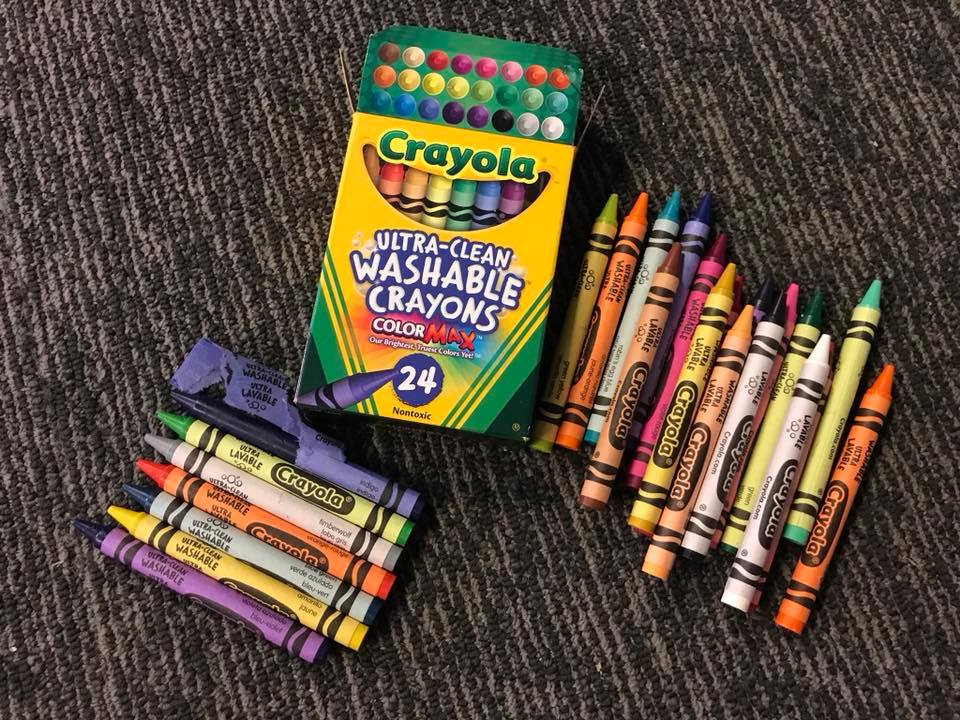
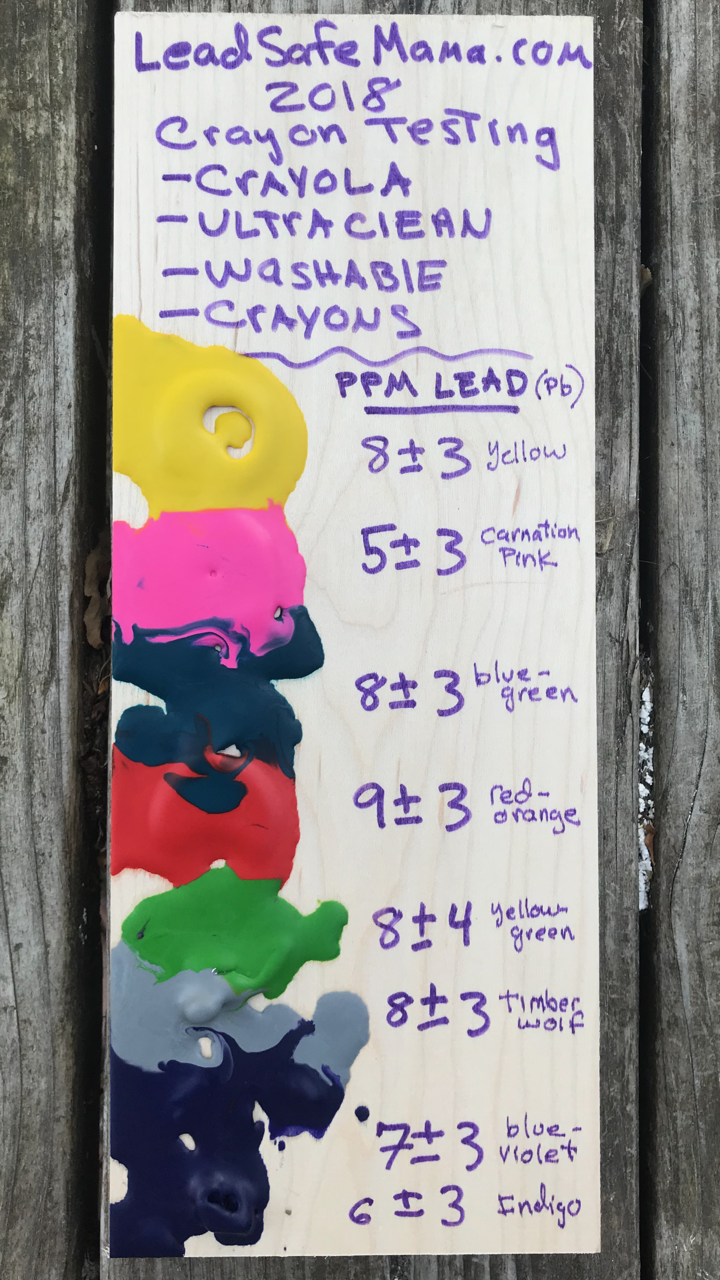
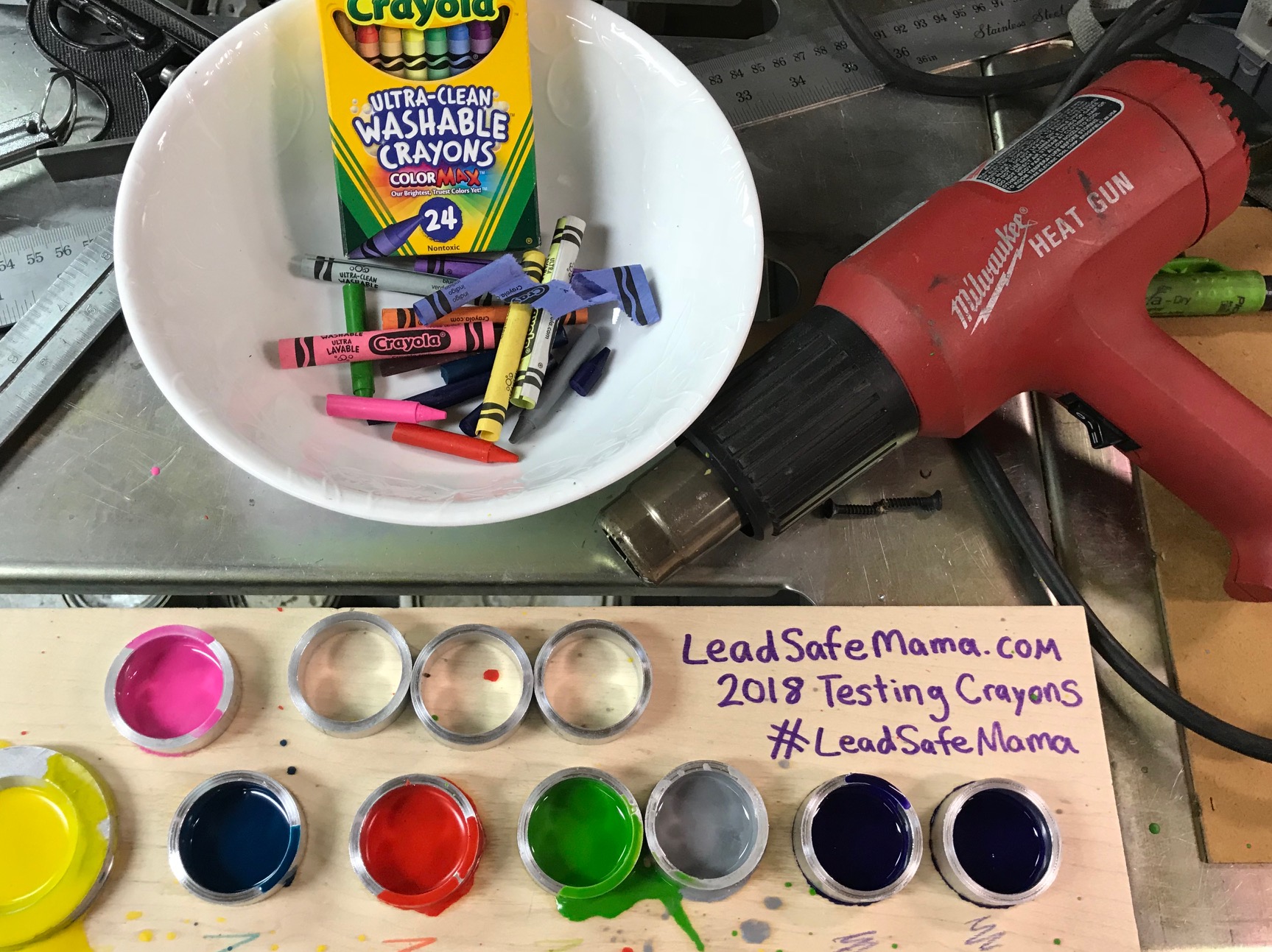
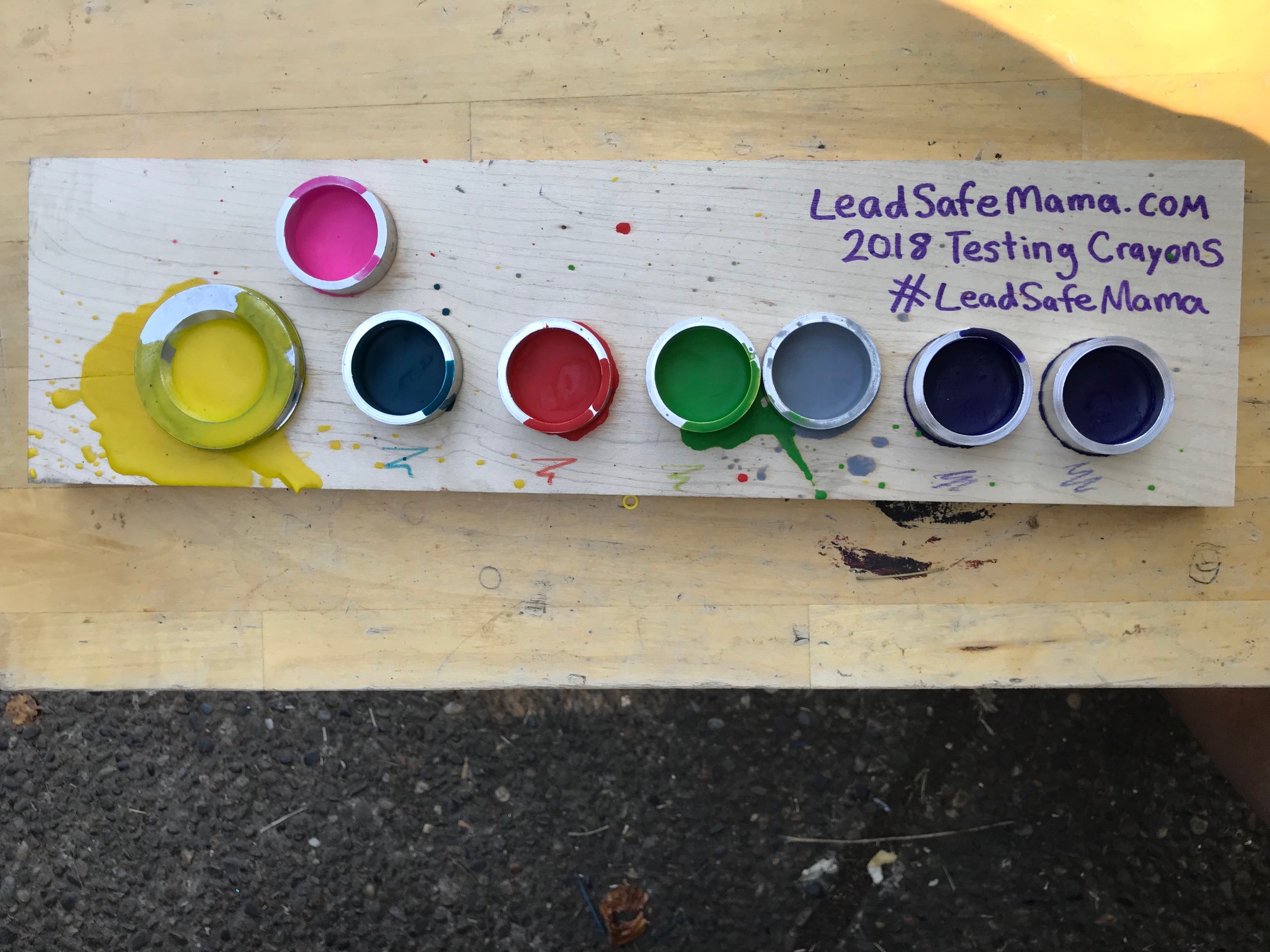
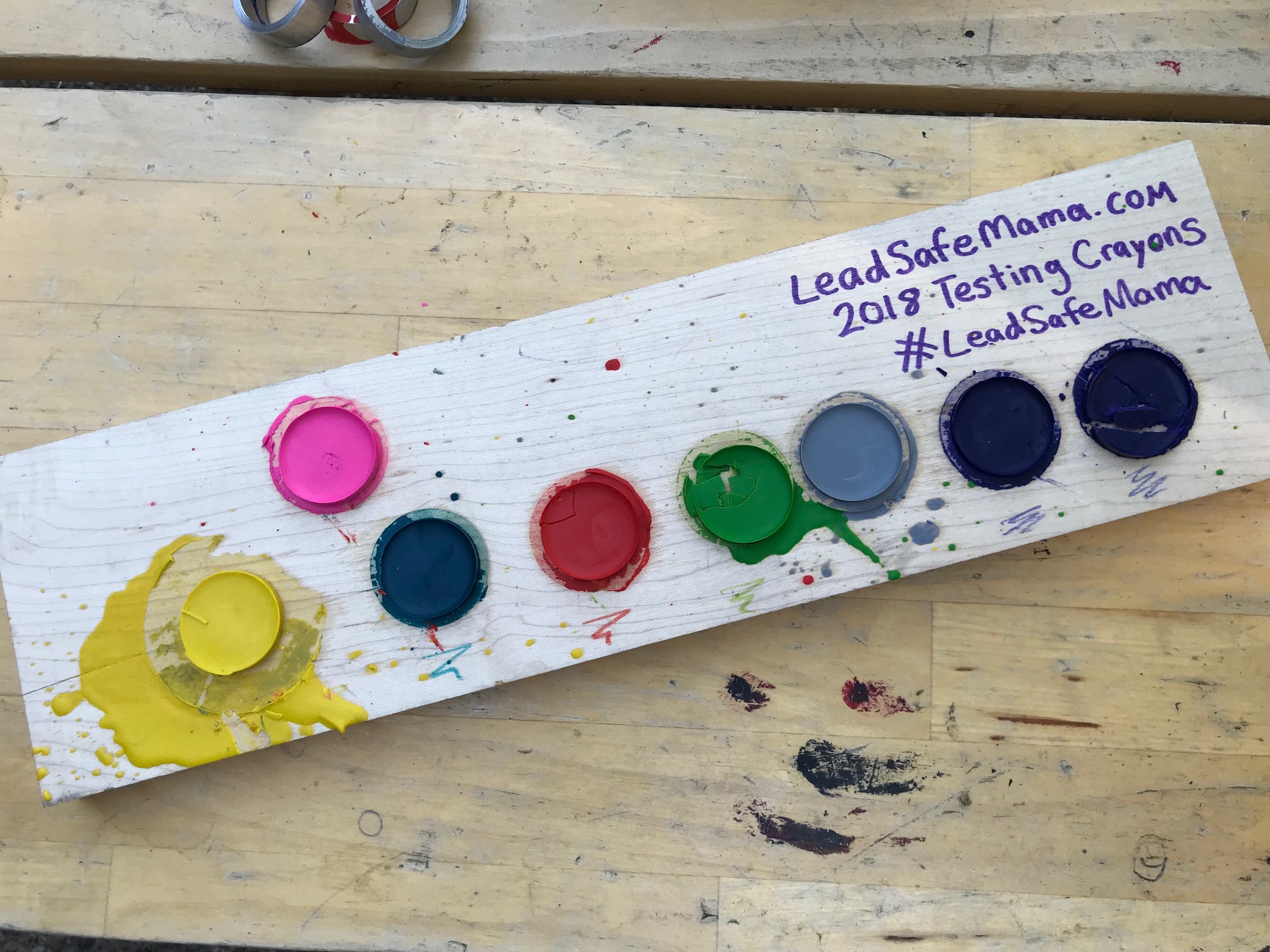
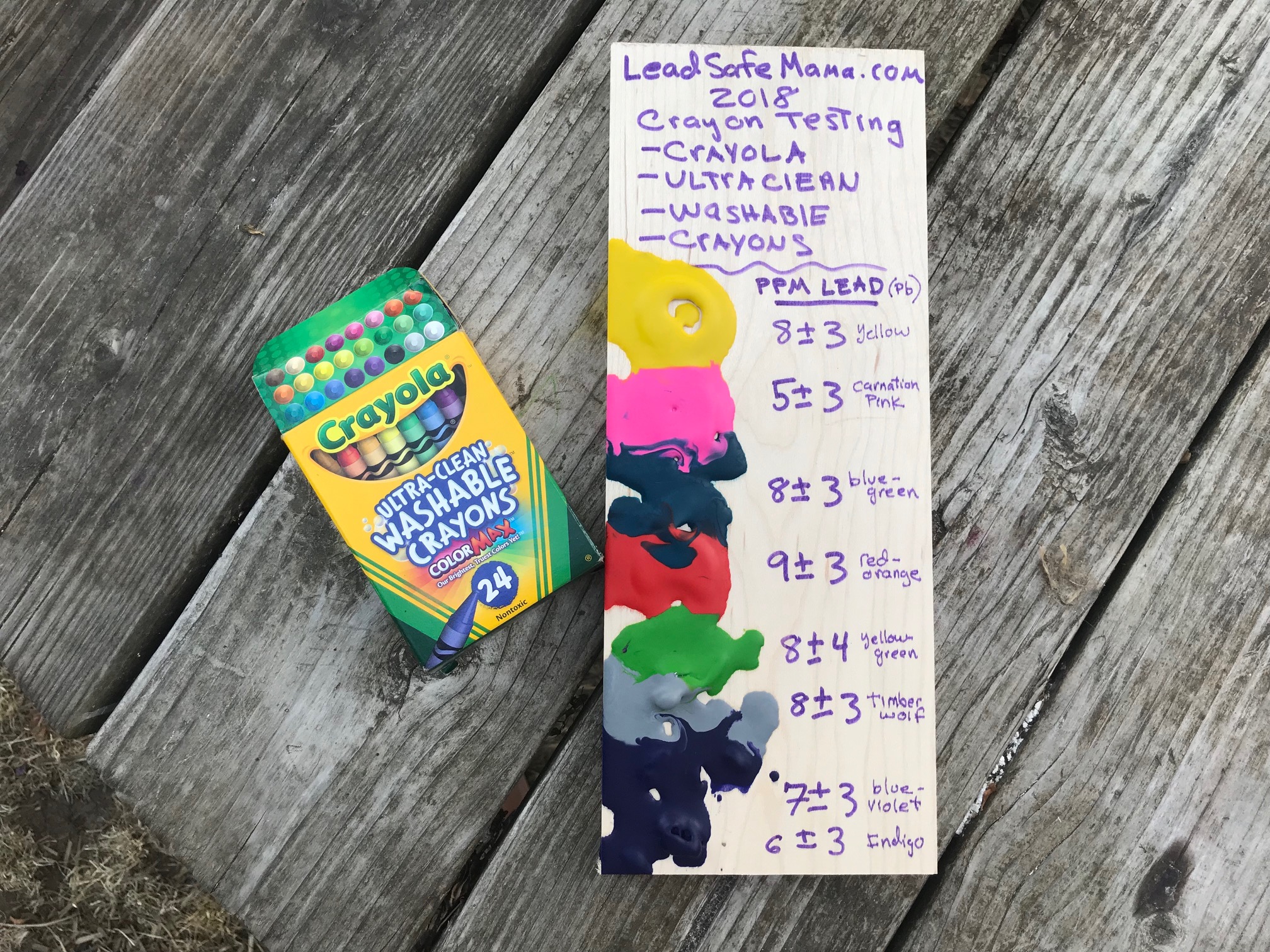

thanks for the post Tamara. One suggestion: when you list the levels in ppm, also list the ppb,
like:
5 ppm / 5,000 ppb
Hi Tamara,
Thank you so much for your work. How can I get a kit to test the lead content in my China?
Thanks so much!
Tzvia
I want to use Artistic pursuits to teach my kids art but where do i find supplies that are non toxic. I am looking for water colors and water colors crayons. Each book has a list of supplies.
I would love to know about watercolor paints too. My daughter frequently draws or paints on herself while doing her artwork (she’s 3). Even though I have tried to get her not too, she will sometimes draw or paint on herself.
You’re doing the work that keeps humanity safe, thank you so much for the time and effort put into this. Also, I applaud the thoroughness of your method and documentation!
Thank you so much Adriana!
How about Arteza kids crayons? In general kids products seems like it would be a really great theme to focus on for blog entries. This blew my mind. Just when I started to think I’m getting to paranoid, in actuality I’m not paranoid enough. Lol
There is so much variability in crayons – I just avoid them as much as possible. For me little kids can use colored pencils (which may have similar toxicity concerns but are less likely to be eaten.) I do have a stack of more different brands to test here in my backlog of items… but I think – as a rule – the industry should be better regulated.
Tamara
Have you ever tested Faber-Castell crayons? Our family can’t use stockmar due to essential oils ♀️ Also any markers?
Hi Tamara,
can you recommend more European brands that are acceptable? I am looking for tempera paint sticks and Faber Castell does not carry them. Thanks
To follow up on my initial comment:
It was apparently 1994 or thereabouts when there was a big lead related recall:
https://www.cpsc.gov/Recalls/1994/cpsc-announces-recalls-of-imported-crayons-because-of-lead-poisoning-hazard
https://www.nytimes.com/1994/04/06/us/crayons-produced-in-china-are-recalled-as-lead-risk.html
Hey, look! Crayons have made LeadSafeMama headlines before!
https://tamararubin.com/2018/08/asktamara-are-my-kids-crayons-toxic-which-brand-of-crayons-is-safe/
Probably related to this:
https://wtop.com/consumer-news/2018/08/study-warns-of-toxic-chemicals-found-in-crayons-back-to-school-items/
Or this:
https://www.ncbi.nlm.nih.gov/pmc/articles/PMC5454070/
Crayola’s pants are on fire?
https://www.crayola.com/faq/safetymsds/are-crayola-and-silly-putty-products-nontoxic-even-if-ingested/#:~:text=All%20Crayola%20and%20Silly%20Putty,even%20if%20ingested%20or%20inhaled.
What about markers? It’s hard to avoid young children getting it all over their hands!
What about ceramic paints, my friend has so many pains and health problems and was in an accident many years ago but she likes to bake ceramic pottery and I wonder if the pottery ceramic paints are bad for her?
Wow. This is crazy! I remember, maybe 20 years ago? Maybe longer..? …there was a Whole Big Thing on the news about how someone found lead in crayons, amd Crayola was the ONLY brand tested that was considered safe. I specifically remember someone saying you could literally eat crayola crayons and be just fine, but that using inferior productcs posed a serious risk, not just by ingestion by by the mere act of melting and becoming soft during use the lead was at risk of being absorbed by the skin or traces reamining on hands could be ingested later and cause harm. How crazy that all these years later, the lead content of crayola has either changed or our standards have changed because we know better or can test more accurately. This is why it is always so important to be open to new information, and why ongoing research into things we thought were settled is SO important. THANK YOU for this information. Have you reached out to Crayola?
Dear Tamara,
My 2 year old granddaughter has taken a couple of bites from an ultra clean Crayola black crayon. We brushed her teeth, had her spit and dug out residue from the molars with a toothpick. What else should we do? The poison control directions don’t seem too concerned about it. I’d like to preempt any neurotoxin issues. What would you do ? Thank you so much for your exhaustive work!
Sincerely,
Cindy